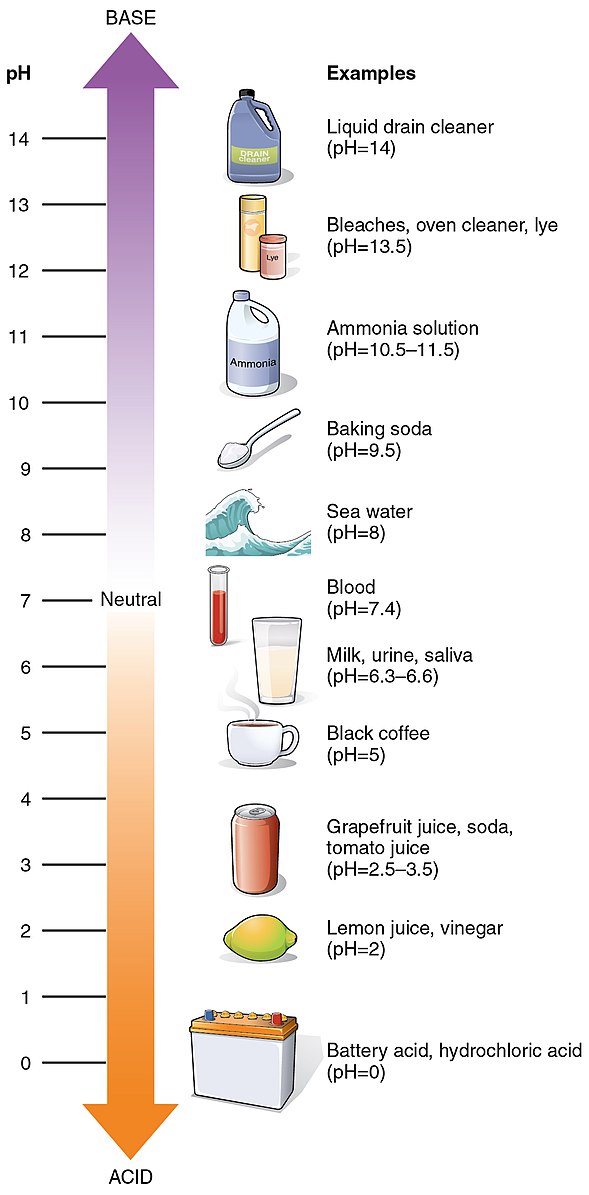Coffee and orange juice are two of the most popular beverages consumed worldwide, but they differ significantly in their pH levels. The pH scale, which ranges from 0 to 14, measures the acidity or alkalinity of a substance, with 7 being neutral. Understanding the pH of these beverages is crucial for maintaining good oral health and making informed choices about what we drink.
The pH of Coffee
Coffee has a pH that typically ranges from 4.85 to 5.10, with an average pH of around 5.0. This means that coffee is slightly acidic, but not as acidic as many other beverages. The acidity in coffee is primarily due to the presence of organic acids, such as chlorogenic, quinic, and citric acids, which are naturally present in coffee beans.
The pH of Orange Juice
 Image source: OpenStax College
Image source: OpenStax College
In contrast, orange juice is significantly more acidic than coffee, with a pH range of 3.3 to 4.2. This means that orange juice is approximately 100 times more acidic than coffee. The high acidity in orange juice is primarily due to the presence of citric acid, which is the predominant acid in citrus fruits.
Comparing the Acidity
The difference in pH between coffee and orange juice is significant, as the pH scale is logarithmic. This means that a difference of one pH unit corresponds to a tenfold change in hydrogen ion concentration. For example, a pH of 4.0 has ten times the acidity of a pH of 5.0.
To illustrate the difference, consider the following:
| Beverage | pH Range |
|---|---|
| Coffee | 4.85 – 5.10 |
| Orange Juice | 3.3 – 4.2 |
As you can see, orange juice is significantly more acidic than coffee, with a pH range that falls within the erosive category (pH below 4.0).
Dental Erosion and Acidity
The acidity of beverages can have a significant impact on dental health, particularly when it comes to dental erosion. Dental erosion is the loss of tooth structure due to chemical dissolution by acids, and it can lead to sensitivity, discoloration, and even tooth loss if left untreated.
Beverages with a pH below 4.0 are considered extremely erosive, while those with a pH between 3.0 and 3.99 are considered erosive. Given that orange juice has a pH range of 3.3 to 4.2, it is considered an erosive beverage and can contribute to dental erosion over time.
On the other hand, coffee, with a pH of around 5.0, is considered minimally erosive. However, frequent consumption of even minimally acidic beverages can still contribute to dental erosion, especially if proper oral hygiene practices are not followed.
Reducing the Risk of Dental Erosion
To reduce the risk of dental erosion from consuming acidic beverages, it is recommended to:
- Consume acidic beverages in moderation.
- Rinse your mouth with water after drinking them.
- Use a straw to minimize the contact between the beverage and your teeth.
- Maintain good oral hygiene practices, such as brushing twice a day with a fluoride toothpaste and flossing daily.
Additionally, testing the pH of your beverages using litmus paper or pH test strips can help you make more informed choices about what you drink and to balance your pH intake.
Conclusion
In summary, coffee has a pH of around 5.0, while orange juice is significantly more acidic, with a pH range of 3.3 to 4.2. This means that orange juice is approximately 100 times more acidic than coffee. The difference in acidity can have a significant impact on dental health, particularly when it comes to dental erosion. To reduce the risk of dental erosion, it is important to consume acidic beverages in moderation, practice good oral hygiene, and consider testing the pH of your beverages.
References:
– Understanding Coffee Acidity – Origin Coffee Roasting. https://originroasting.co.za/blog/understanding-coffee-acidity/
– Acidity of Coffee – Home-Barista.com. https://www.home-barista.com/knockbox/acidity-coffee-t21699.html
– The pH of beverages available to the American consumer – PMC – NCBI. https://www.ncbi.nlm.nih.gov/pmc/articles/PMC4808596/
